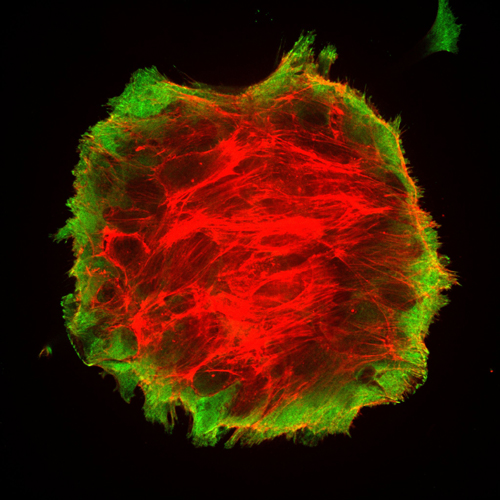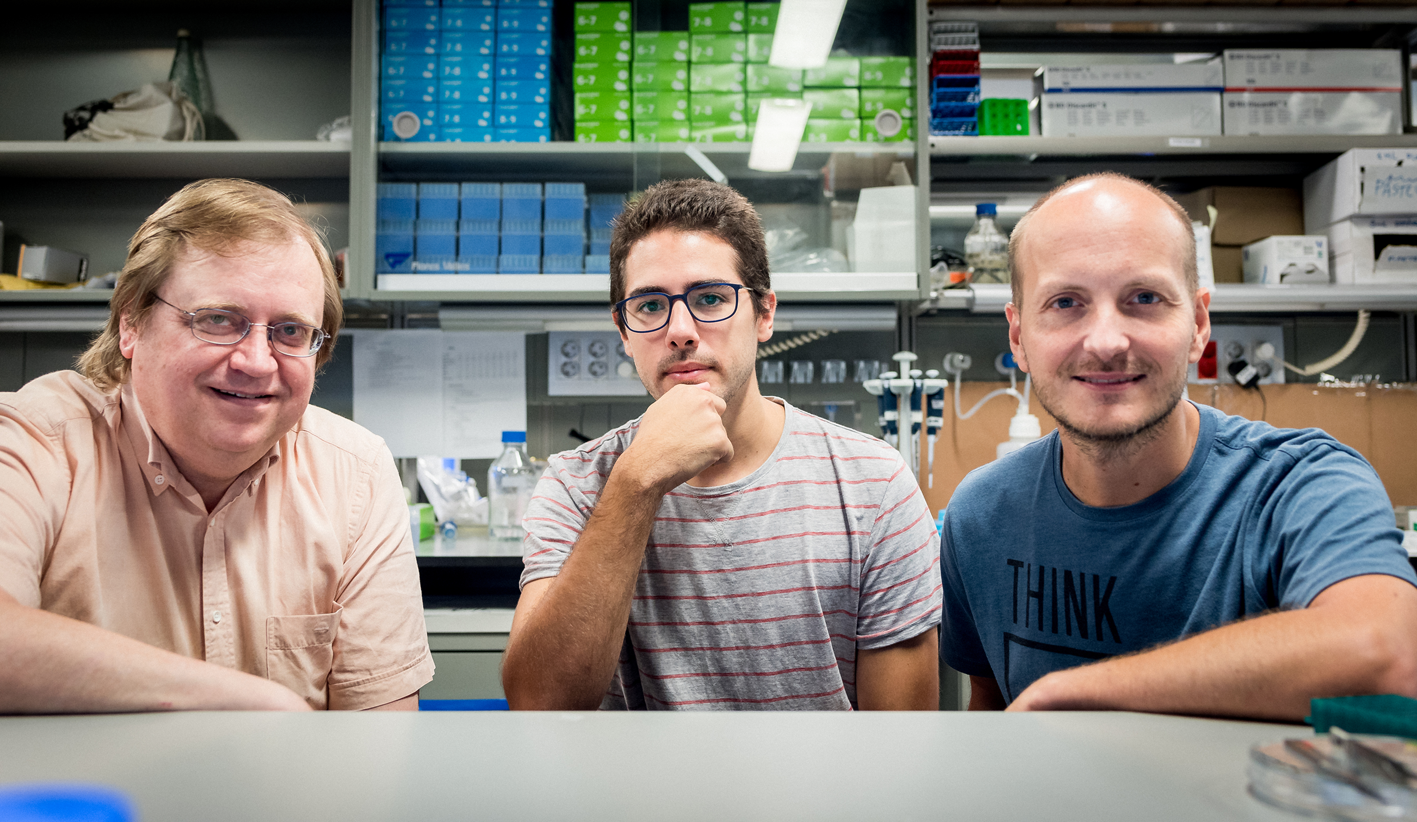A malignant tumor is characterized by its ability to spread. To do this, tumor cells adhere to the surrounding tissue – mainly collagen – and exert forces on it to propel themselves along.
In a study published today, a team led by Xavier Trepat, ICREA research professor and group leader at IBEC, and Jaume Casademunt, professor of physics at the University of Barcelona (UB), unveiled the forces that the tumor cells exert in order to spread. Surprisingly, the relationship between these forces and cell movement transcends the laws of physics as they are currently understood.
Above: Breast cancer cells attached to a surface rich in collagen. The actin cytoskeleton can be seen in green, coated with active myosin (ppMLC) in red, and the cell-cell junctions (E-cadherin) in blue.
The researchers placed breast tumor cells on a collagen-rich surface and observed how they spread. Technology developed by the IBEC group allowed them to measure the physical forces exerted by the cells during this process, something that had not been achieved until now.
With this method, they discovered that the dispersion of the tumor depends on a competition between forces: the cells cling to each other, staying together and, at the same time, cling to their environment to escape. Depending on which force prevails, the tumor will maintain a spherical shape or spread completely over the surface.

“It’s similar to what happens when we put a drop of water on a surface,” explains Carlos Pérez, a researcher at IBEC and first author of the article. “On some surfaces, the drop will complete scatter, as on a tile, while on others it will remain almost spherical, as on the impermeable fabric of an umbrella.”
Despite these similarities between tumors and everyday fluids, the physics of both phenomena is actually very different. “The wetting of surfaces is a central problem of classical physics that we understand very well. However, tumors seem to be governed by very different laws,” says Ricard Alert, a researcher at the UB and co-author of the article. Unlike passive fluids, cells are able to generate forces and move by themselves. This converts biological tissues into active fluids and, in particular, tumors into active drops. As a result, understanding the expansion of tumors on a surface has required the development of a new physical theory that researchers have called ‘active wetting’.
“When we think of states of matter, we usually think of solids, liquids or gases. Our results and those of other laboratories indicate that living cells do not fit into this scheme and behave like another form of matter, which we call active matter,” elaborates Jaume Casademunt.
When a tumor appears, the cells accumulate mutations and their mechanical properties change. Generally, the tumor cells lose unions between them and gain connections to their environment. As the tumor grows, the environment itself is also modified, increasing its amount of collagen and its rigidity.

“Our experiments reveal that these changes are enough for the balance of forces of a tumor to be altered, causing the cells to begin to spread through their environment,” explains IBEC’s Xavier Trepat.
This discovery highlights the importance of physical forces in metastasis, opening the door to developing therapies to alter the mechanics of tumors as a possible treatment.
The study was financed by MINECO, the Generalitat de Catalunya, the European Research Council (ERC), the EC (under the MECHANOCONTROL project), CIBER-BBN and the Obra Social “La Caixa”.
—
Carlos Pérez-González, Ricard Alert, Carles Blanch-Mercader, Manuel Gómez-González, Tomasz Kolodziej, Elsa Bazellieres, Jaume Casademunt, Xavier Trepat (2018). Active wetting of epithelial tissues. Nature Physics, epub ahead of print
IBEC in the Media:
«Los elementos de un tumor pueden generar fuerzas que los autopropulsen»
La Razon
Investigadores revelan expansión células tumorales desafía a la física actual
COPE
“Ho han descobert investigadors de l’Institut de Bioenginyeria de Catalunya i de la …”
RAC1
La expansión de células tumorales desafía la física actual
Agencia SINC
Tumor cell expansion challenges current physics
Phys.Org
Tumor Cell Metastasis Challenges Laws of Physics
Technology Networks
Revelen que les cèl·lules tumorals desafien la física actual
El Punt Avui
La física també vol curar el càncer de mama
ARA
Cancer’s Spread May Depend on Weird, Newfound Fluid Physics
Live Science





